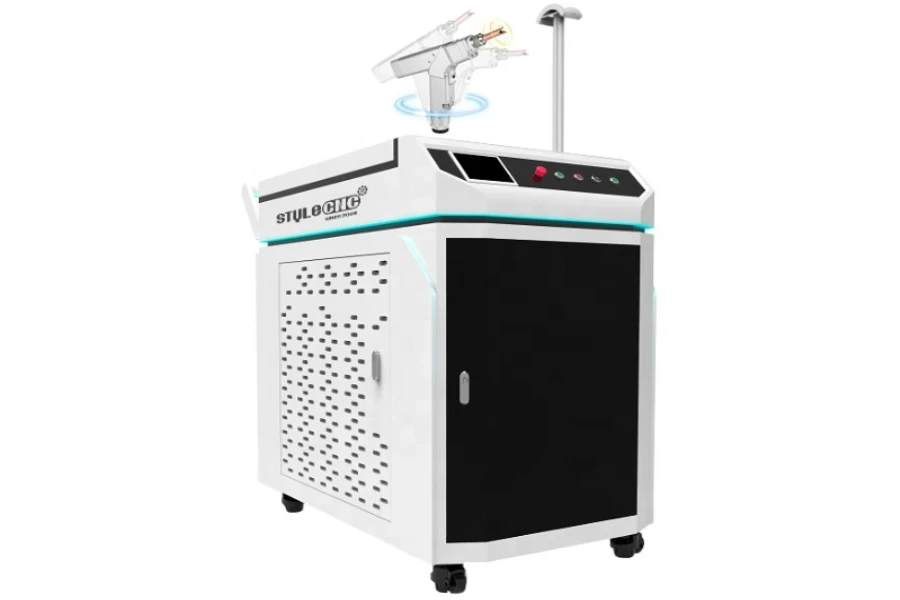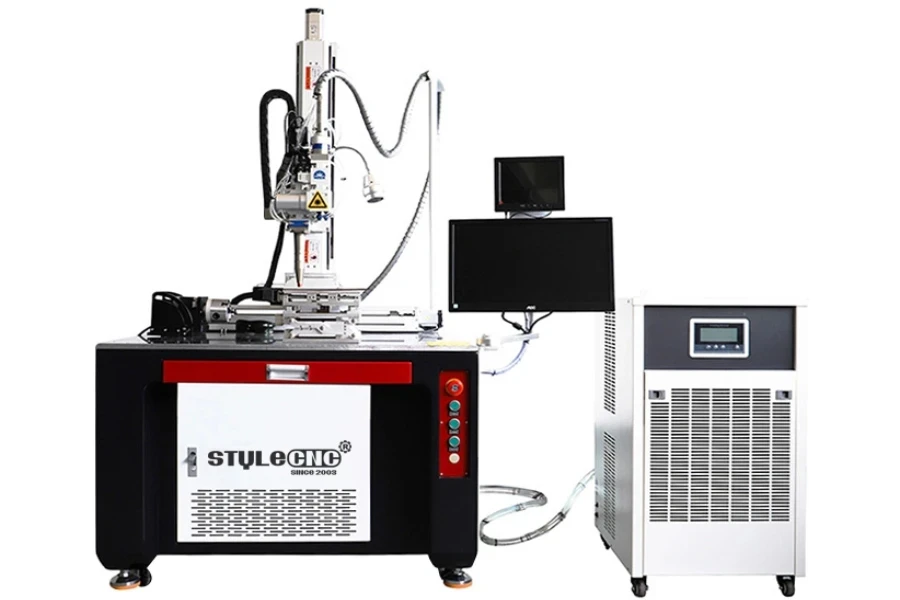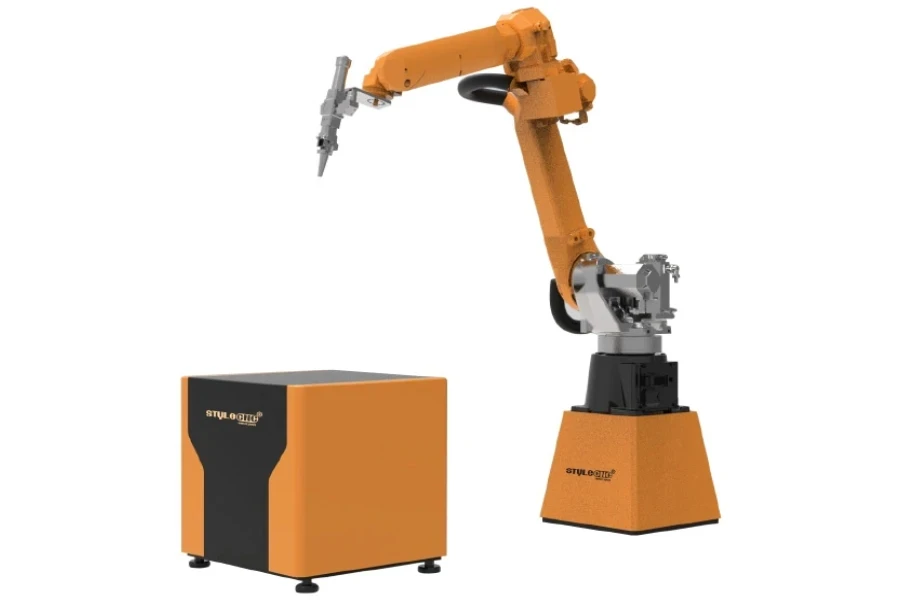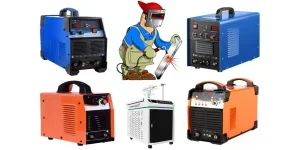Table of Contents
What is a welding machine?
What are the 12 most common types of welder?
Things to consider
FAQs
What is a welding machine?
A welding machine is a professional power tool that provides the energy and motion to join two or more parts. It is made from metals or thermoplastics and includes a control system for the motions of the wire and torch.
You will find many types of welder for metal fabrication on the market, which can make it difficult to choose a suitable welding machine for your business. In this article, we discuss the 12 most common welder types.
What are the 12 most common types of welder?
Laser welder
Laser welders are smart welding systems that join metal parts using a laser beam. This type of welder uses the high heat conduction of the laser beam to melt the metal and so form a molten pool that can then be used for welding. The weldable shapes achievable via a laser welder include points, lines, circles, squares, and any drawing created using AutoCAD software.
Laser welders use a laser beam as the heat source. By doing so, these welder types have a repair function that can deposit, seal, and fill any damage caused by wear, scratches, pinholes, cracks, defects and deformations, or any other metal molds and parts defects. They can also reduce hardness and sand holes. These laser welders can perform precise welding on even thin-walled materials and parts, carrying out spot, butt, stitch, and sealing welding.
The laser welding machine is a new type of welding tool that works at high speeds with high positioning accuracy on a small heat-affected zone, all while creating a smooth welding seam. Easily maneuverable portable laser welders are also available as handheld laser welding guns. Additionally, paired with the CNC controller, these laser welder guns will be built as automatic laser welders used to finish welding jobs without human intervention. By adding a robotic arm, laser welding robots will also be created for 2D/3D welding projects and plans.
Below are some photos of the mentioned laser welders:



Plasma welder
Plasma welders are a type of professional but easy-to-use welding machine. These welders can utilize a transferred arc between the tungsten electrode and the metal part, or they can use a non-transferred arc between the tungsten electrode and the nozzle. These welders employ the plasma gas sprayed from the welding torch as a type of protection and supplement an auxiliary shielding gas around it.
Plasma welding uses a plasma arc as the heat source. This happens thanks to the special compression effect of the plasma arc torch, which transforms the ordinary tungsten arc into a plasma arc with high energy density, high temperature, and high arc stability. When this plasma arc is used as the heat source, it displays strong penetration ability and high speeds. Using this type of welder allows a wide range of applications, as the heat-affected zone is small and the adjustable range of the welding current is large.
Plasma arc welding is used to manufacture welded pipe, carry out small size welding on thin plate components and equipment, and weld pipe roots and thin-walled pipe. It also has some applications within electron beam welding, while offering the advantage of much lower equipment costs.
TIG welder
TIG welders are a type of portable welding tool that adopts the high-voltage breakdown arc starting method for welding. TIG welding refers to tungsten inert gas shielded arc welding, which uses industrial tungsten or active tungsten as non-melting electrodes and inert gas (argon) as protection. TIG welding is suitable for non-ferrous metals and alloy steels that are easily oxidized (Al, Mg, Ti and their alloys, and stainless steel). This type of welder is suitable for single-sided welding and double-sided forming, such as bottoming and pipe welding. It is also suitable for welding thin sheet metal.
TIG welding technology is based on the principle of ordinary arc welding, using argon gas to protect the metal material. Here, the high current melts the material on the substrate to be welded into a liquid state, thereby creating a molten pool to join the metal to be welded with the material. This welding method achieves a metallurgical combination of materials. Additionally, due to the continuous supply of argon gas during the high-temperature fusion welding, the welding material never comes into contact with the oxygen in the air, thereby preventing oxidation.
MIG welder
MIG welders are high-speed arc welding machines that use a melting electrode and an external gas as an arc medium. These welders protect the weld pool from metal droplets forming due to high temperature in the heat affected zone (HAZ).
MIG is the English acronym for Metal Inert Gas. The inert gas (Ar or He) shielded arc welding method with solid wire is known as molten electrode inert gas shielded welding, or MIG welding for short.
In this welding method, the tungsten electrode in the torch is replaced by a wire, while the others remain the same as in the TIG welding method. Due to this set up, in MIG welding the wire is melted by the arc and fed into the welding zone. Electrically driven rollers then feed the wire from the spool to the torch, as needed for welding. As with TIG welding, the heat source is a DC arc, however, the polarity is reversed from that used in TIG welding. The protective gas used is also different. In order to improve the stability of the arc in this welding method, 1% oxygen should be added to argon.
MIG welding, like TIG welding, can weld nearly every metal type, however, this welding type is especially suitable for aluminum and aluminum alloys, copper and copper alloys, and stainless steel. In these welds, there is almost no oxidation or burning loss, and only a small amount of evaporation loss. The metallurgical process is also relatively simple.
AC welder
AC welders use an alternating current via a special step-down transformer that is located inside the machine, and then output low-voltage and high-current electric energy for welding. AC stick welders (an alternative to current stick welders) have the advantages of a simple structure, easy maintenance, and no magnetic deviation during welding. These high-power welding machines barely use 506 electrodes when using ordinary electrodes, stainless steel electrodes, and cast-iron electrodes. AC welders can be used to weld a wide range of base metals, only failing to weld certain special materials, such as gold, silver, copper, and tin.
DC welder
DC welders work by converting an alternating current into a direct current via a rectifier converter. DC stick welders (direct current stick welders) have the advantages of being small in size and light in weight. However, despite their compact nature, the structure of these welders is relatively complex, which makes maintenance difficult.
DC stick welders carry out the same functions as AC stick welders, but with better performance. In addition, DC stick welders can weld special materials and special electrodes. Understandably then, DC stick welders are more widely used than AC stick welders.
CO2 gas-shielded welding machine
Carbon dioxide gas shielded welding machines, commonly known as CO2 welders, consist in an advanced fusion welding system that uses the carbon dioxide gas ejected from the nozzle as a protective gas to isolate the air and protect the molten pool. These welders are easy to use and are suitable for automatic welding and omnidirectional welding. These welders are suitable for indoor use, however, it is important to pay attention to the working environment and gas protection.
The input voltage of a low-power CO2 gas shielded welder machine is generally 220V AC, while a high-power CO2 gas shielded welder machine uses 380V AC power. The output voltage is generally 12 – 36V. This welder type is mainly used for low-carbon steel, low-alloy high-strength steel, and thin plate and medium-thick sheet metal welding. It is also commonly used for high production outputs.
Butt welder
Butt welders are a type of resistance welding machine. These welders employ resistance heat alongside a large amount of plastic deformation energy in the welding zone itself to join the two separated metal atoms to the lattice via the formation of metal bonds. In this way, butt welders generate surface grains to obtain solder joints, welds, or butt joints. These welders offer a stable connecting method, high production efficiency, and easy realization of mechanization and automation.
Butt welding machines use the resistance between the contact surfaces of the two parts to generate a low voltage and large current to instantly heat, melt, and fuse the contact surfaces of the two butt-jointed metals. According to different methods, butt welding equipment can be divided into flash butt, steel butt, and copper rod butt welding equipment.
Butt welding can join various metal sheets, pipes, bars, profiles, solid parts, and knives together, as well as welding non-ferrous metals and alloys such as low carbon steel, high carbon steel, alloy steel, and stainless steel. It is widely used in automobiles, aerospace, electronics, and household appliances.
Flash butt welder
A flash butt welding machine is a butt welder used for the longitudinal connection of steel bars with prestressed steel bars and screw end rods. The principle of flash butt welding steel bars is to use butt welding equipment to connect the steel bars at both ends. To form a butt welded joint using this method, a low-voltage strong current is used to heat the steel bars until they become soft, after which axial pressure upsetting is performed.
Flash butt welding can be divided into continuous and preheated flash butt welding: Continuous flash butt welding consists of a flash stage and upset stage, while preheat flash butt welding adds a preheat stage before the flash stage.
The flash stage of butt welding uses the heat generated by the contact resistance to heat the metal part. In this way, the metal surface is melted, the temperature gradient is large, and the heat affected zone is relatively small. With flash butt welding, the weld is formed when the plastic deformation of the counterpart solid phase metal forms a common grain. The weld structure and composition are close to the base metal (or after heat treatment), and it is relatively easy to obtain equal-strength and equal-plastic welded joints. The flashing process has the self-protection function of eliminating the air to reduce metal oxidation.
Using the upset forging stage in flash butt welding can drain oxides from the liquid metal and out of the weld. Weld inclusions, incomplete penetration, and other defects become less significant when using this method. Additionally, through this stage the flashing process takes on a strong self-adjustment function, with low requirements for strictly maintaining the specification and consistency, and the welding quality is stable. The electric power requirement per unit of welding in each cross-sectional area is small, while only (0.1-0.3) KVA/mm2 electric power is required for low carbon steel.
Spot welder
Spot welders are a type of resistance welding machine that assemble the weldment into lap joints and then press them between two cylindrical electrodes. These welders then use resistance heat to melt the base metal into a solder joint.
The spot welder machine uses the high-temperature arc generated when the positive and negative poles are short-circuited. It uses this temperature to melt the material to be welded between the electrodes and so weld the materials together. The main component of the electric welding equipment in a spot welder is a step-down transformer. Here, the two ends of the secondary coil are the welded metal part and the welding rod. The arc is ignited when working, and once it reaches a high temperature the rod is fused into the gap of the metal part.
Spot welding machines are used for repairing gold and silver jewelry, spot welding blisters, repairing seams, and inlaying parts. They can also be used for false filling blisters and for micro-precision parts such as integrated circuit leads, battery nickel strips, picture tubes, electron gun assembly, and watch hairsprings. The heat-affected zone when welding with a spot welding machine is small and the size of the nickel spot can be easily adjusted. The solder joints are fine, flat, and smooth, without the need for excessive post-weld treatment, and can be accurately positioned.
Spot welders are fast, offer high quality welds, and the solder joints are pollution-free and efficient. This welder type is suitable for various metals such as gold, silver, platinum, stainless steel, and titanium and its alloys.
Stick welder (shielded metal arc welder)
Stick welding is also known as SMAW (Shielded Metal Arc Welding), which is a type of manual metal arc welding method that uses consumable electrodes with flux for joint welding (informally known as flux shielded arc welding).
A stick welder works with a wire feeder to feed its flux-cored wire and solid wire, thereby making wire feed easy. The flux-cored wire includes gas-shielded flux-cored wire and self-shielded flux-cored wire. The solid wire is also known as solid metal core wire, which is ideal for outdoor use.
SAW welder (submerged arc welding machine)
SAW welders are also known as submerged arc welder machines. These are a type of melting electrode electric welding machine which uses granular flux as the protective medium, with the arc hidden under the flux layer. First, granular flux is evenly deposited on the welding seam of the weldment. Next, the contact tip and the weldment are respectively connected to two stages of the welding power source to generate the arc. Finally, the welding wire is automatically fed and the arc is moved for welding. Submerged arc welders can weld carbon structural steel, low alloy structural steel, stainless steel, heat-resistant steel, nickel-based alloy, and copper alloy.
Pros
The pros of SAW welders include high weld quality, good slag isolation, and air protection, with the main component of the arc area being CO2. In SAW welders, the nitrogen content and oxygen content in the weld metal are greatly reduced, the welding parameters are automatically adjusted, the arc travel is mechanized, the molten pool lasts a long time, and the metallurgical reaction is sufficient and shows strong wind resistance. All this allows for a stable weld composition and good mechanical properties. Additionally, the slag isolates the arc light allowing for better welding operations, mechanized walking, and low labor intensity.
Cons
Flux retention means there are limitations in the achievable welding positions when using a SAW welder (unless special measures are taken). Submerged arc welding is therefore mainly used for seam welding in horizontal and downward position, as it cannot be used for horizontal, vertical, or overhead welding. Additionally, due to the limitations in welding materials for SAW welders, it is not possible to weld aluminum, titanium, or other highly oxidizing metals and their alloys.
High frequency welding machine
High frequency welding machines are different from other welders, since they offer more functions than just welding. These welders have fast heating speeds and high efficiency, and are able to instantly melt any metal object.
In addition to welding various metal materials, high frequency welders can be used for diathermy, smelting, heat treatment, and other processes. They are suitable for heat treatment quenching, annealing, metal diathermy forging, extrusion forming, and solder welding. Moreover, since these welders are small and only weigh a few kilograms they do not require acetylene cylinders or oxygen cylinders, making them easily portable and efficient in outdoor or harsh environments.
Pressure welding machine
Pressure welding machines are a type of welder table that count with a floating device. This means pressure does not directly act on the turntable, which in turn helps achieve the precise positioning of the hot pressure welding and so realize precise welding. Pressure welders adopt a positioning device on the floating device. This means that when working, pressure welders can overcome any position deviation caused by the use of the floating device. This way the template and the head fastened to the floating plate do not move back and forth, or left and right. Additionally, a certain vertical pressure is applied to the upper end of the knife. Thus, under the combined action of these two forces, the aluminum wire under the riving knife will regularly creep through the control of time.
The best conditions must be selected to obtain high tensile strength points. These conditions depend on factors such as ultrasonic vibration power, pressure, and ultrasonic vibration time. These three factors should be properly matched in order to adjust the best point.
Pros
Electric welding machines use electric energy, which is easy to obtain, to instantly convert electricity into heat. This makes electric welding machines easy to use in many locations. Electric welding equipment has very few requirements and is even suitable for working in dry environments.
Thanks to the small size, simple operation, ease of use, high speeds, strong seams, and other advantages of these welding machines, they are widely used in various fields, especially for parts that require high strength. Following heat treatment by electric welding machines, the welded material will have the same strength as the base metal, and the sealing will be very good. This solves the problems of sealing and strength for the manufacturing of storage gas and liquid containers.
Cons
When using electric welding machines, a certain magnetic field will be generated around the machine. This is a concern as when the arc burns, it will generate radiation in the surrounding area. The arc possesses infrared, ultraviolet, and other light species, as well as metal vapor, smoke, and other harmful substances. For this reason, adequate protective measures must be taken when operating these electric welding machines.
Welding with these electric welders is not suitable for high carbon steel. This is because the ensuing crystallization, segregation, and oxidation of the metal after welding will mean that the high carbon steel will have poor performance and will crack easily after welding, resulting in hot and cold cracks. Low carbon steel on the other hand, has a good performance when welded with this welder, however, it must be handled properly during the welding process, and the cleaning of rust is cumbersome. Sometimes there will be defects such as slag inclusion, cracks, stomata, and undercuts in the weld, but proper operation will reduce the occurrence of these defects.
Things to consider
Now that you have read this article, do you feel more comfortable with the different types of welding machine? Whether a beginner or a professional welder, you should know how to choose the right welder before buying your welder online with free shipping.
FAQs
What is welding?
Welding is a method that uses heat to connect different pieces of metal together. Welding forms a permanent and firm bond between two metals via the diffusion of atoms or molecules of the welding material on the contact surface of the two metals. The joints formed by connecting by welding are called solder joints.
What is solder?
Solder is a fusible metal with a low melting point, high mechanical strength, low surface tension, and strong oxidation resistance. The solder used for hand soldering is a tin-lead alloy.
What is flux?
Flux is a material that removes oxides, sulfides, oils, and other contaminants from the metal surface and prevents the solder from oxidizing during heating. It also has the characteristics of enhancing the activity of solder and metal surfaces and increasing wetting. Flux generally uses super rosin as the matrix material and adds an activator, such as diethylamine hydrochloride.
What is solder mask?
Solder mask (solder resist) is a high temperature resistant coating that is used to protect the parts of a printed circuit board that do not need soldering. Different types of solder resist include thermal curing solder resist, ultraviolet light curing solder resist (photosensitive solder resist), and electronic radiation curing solder resist.
What is solder wire?
Solder wire is a solder used for manual soldering. It is made from flux and solder, with a solid flux entrained in the solder tube. Since different tin and lead components have different melting points, it is important to select the right materials for the solder wire. Commonly used solder wires are Sn63Pb37 with a melting point of 183°C and Sn62Pb36Ag2 with a melting point of 179°C. Solder wire is tubular, with diameters of 0.2, 0.3, 0.4, 0.5, 0.6, 0.8, 1.0 and other specifications. Solder wire of 0.5 and 0.6 can be used for welding perforated components.
What is arc spot welding?
Arc spot welding is a welding method that uses thin plate lap joints, TIG/MIG/MAG/CO2 welding, and a certain welding current to form a surface nugget and connect the upper and lower plates within a set time.
How to weld at home for a beginner?
The most common arc welding machines do not work at home, as the current required for arc welding is less than tens of amps and home protectors will jump. So, TIG, MIG, MAG can be excluded.
Resistance welding and thermocompression welding are too large for home use, while the disadvantage of using oxyacetylene gas welding at home is that the flame temperature reaches 3000+. If you are not careful, your home will be set on fire.
The most reliable way to weld at home is using brazing, which requires high-frequency heating. Soft brazing is the most suitable brazing option. However, you also need to consider what it is that you are soldering, since the metal bonding strength is not high with soft brazing.
Laser welding, plasma welding, and electron beam welding are a bit expensive but their welding quality is good, their speed is fast, and they can be used at home.
Source from stylecnc.com
Disclaimer: The information set forth above is provided by stylecnc independently of Alibaba.com. Alibaba.com makes no representation and warranties as to the quality and reliability of the seller and products.




